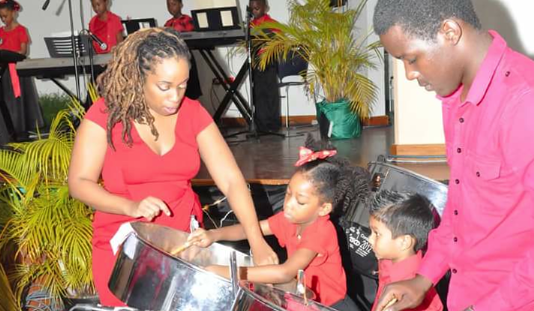 In this piece, IIRP Graduate Keisha Martinez ('17), a licensed music therapist and founder of Music Inspiring Change, explores how music therapy combined with restorative practices can help prison inmates and heal trauma.
In this piece, IIRP Graduate Keisha Martinez ('17), a licensed music therapist and founder of Music Inspiring Change, explores how music therapy combined with restorative practices can help prison inmates and heal trauma.
Special thanks to the European Forum for Restorative Justice (EFRJ) for allowing us to republish this article, which first appeared in their June 2017 Newsletter Volume 18(2). This article will be part of a forthcoming EFRJ publication on the theme of "Arts and RJ." EFRJ welcomes other submissions for this booklet by October 1, 2017.
- Murder and Mayhem!
- 3 more murdered overnight
- Girl, 5, father shot dead
- Killers run rampant as six murdered
— all recent headlines in Trinidad and Tobago, a vibrant twin-island republic at the southernmost end of the Caribbean chain of islands, best known for being the birthplace of steelpan and calypso. Trinidad and Tobago has struggled for decades with escalating crime rates, poverty and political corruption. In 2016 alone, the small nation of approximately 1.6 million recorded 463 murders, over 1000 domestic violence reports and 915 cases of child sexual abuse over a nine-month period (May 2015–February 2016). Music Inspiring Change was founded five years ago, in the context of this society.
I began my music therapy career with a passion for working with prison inmates, both adults and children. I felt that they had been neglected by the larger society, and that providing them with psychotherapeutic services would help them achieve the healing and restoration they would need to function after their incarceration. My practice has since expanded to children and teenagers from at-risk communities, or what our government labels as "hot-spots" for crime and nefarious activities, children with HIV/AIDS and victims of violent crime. All of this work is geared toward creating an anti-violence movement that counters the violent, angry culture that has become the local norm.
Music therapy is the use of music and music-related activities by a qualified professional to address nonmusical goals in the areas of communication, cognition, sensor-motor skills and socio-emotional behavior. We can work in special education programs, schools, prevention and wellness programs, hospices and hospitals, criminal justice facilities, inpatient and outpatient psychiatric facilities, drug and alcohol treatment programs, nursing, daycare, residential homes and private clinics. Music therapists often work with clients with developmental disabilities, such as autism and cerebral palsy, mental illnesses, such as schizophrenia and depression, physical rehabilitation needs, such as Parkinson’s disease or stroke survivors, emotional needs, such as trauma patients or sexual abuse survivors, and medical illnesses, such as cancer and liver diseases. We may also work with normally functioning people, for example, via stress management in workplace settings or in collaboration with fitness and yoga instructors.
Where does restorative justice come in?
I worked for three months with a group of prison inmates described by officers as "severely disturbed." Our main goals included:
worked for three months with a group of prison inmates described by officers as "severely disturbed." Our main goals included:
- helping them to identify and express their emotions in a healthy manner,
- presenting alternatives for anger management and
- reducing anxiety and depression.
During one music therapy session, I placed words describing feelings or emotions into a paddle drum, and the group played a version of "hot potato." A lively song was played on a CD player, while inmates passed a ball around the circle. Every time the music was paused, the inmate who held the ball was required to pick out an emotion and answer questions about it. After the game, the group had a discussion of the importance of understanding our own emotions. During the discussion, the word "empathy" came up. One 42-year-old inmate, who is particularly feared in the prison community, nicknamed "Animal," appeared confused.
"But miss, why would I want to try to figure out how someone else was feeling? Wouldn’t that mean that I would be making them more important to me in my brain? That doesn’t make sense!"
The concept of empathy for others was foreign and strange to the group. Throughout subsequent sessions, group activities were geared toward helping them understand the effects of their actions on others. After the three-month treatment period, inmates were ready to begin the process of engaging in restorative interventions with other professionals.
With "Animal," I began to see the possible intersections between restorative practices and music therapy. Most obviously, the concept of circle facilitation and processes as a regular format stood out to me. In my first training in restorative practices, I was reminded of the drum circle, a frequent tool in music therapy, in which, just like restorative circles, everyone’s contributions are valued and respected, everyone is equal, and the "spiritual and emotional aspects of individual experience are welcomed" (Pranis, 2015). The music therapist is primarily concerned with the development of individuals within their communities and helping people to heal and restore themselves wherever possible. We tailor our activities to individual clients, using their preferred music to meet their needs, allowing their goals and needs to guide our process.
As my restorative journey continued, I began to look for ways to incorporate traditional restorative practices with my therapy practice. Male inmates at a local jail, selected because of issues with substance abuse and addiction, were working with us on their primary goal, which they identified themselves as "healing so we can take care of our families as men." After weeks of therapy, our topic became "forgiveness," and in one session, we spent time discussing ways in which they could ask for and receive forgiveness from family members whom they had hurt. I used the "fishbowl" or solution-focused circle format. Inmates would sit in the centre, tell their story and ask their peers for suggestions to heal their relationships. When the process was complete, inmates would commit to taking deliberate, immediate action toward this goal. The inmate in the center would play a "contract" beat on his drum, which served as a signal that he had made a contractual bond with his group of peers. His peers would repeat the beat on their instruments as a signal that they supported his commitment and would encourage him in his healing.
Sean felt that he had failed his four-year-old daughter, whom he loved dearly but had to leave because of repeated incarcerations for drug possession. During his time at the center of the circle, Sean wept bitterly about his fears for his daughter growing up without him. His peers let him cry and then gave him suggestions for growing his relationship with her, such as writing letters to her, requesting special visits and coloring pictures of animals that she liked. Eventually, Sean committed to creating a CD in therapy that would include him reading bedtime stories and the group singing nursery rhymes to help her learn. By the end of the treatment process, Sean expressed hopefulness and excitement at the possibilities for fathering even throughout his continued incarceration.
Further integration
In 2014, I married Cristiano Martinez, a former prison inmate that I had met many years ago while volunteering as a university student. He had been convicted of manslaughter and attempted murder when he was 16 years old and spent nine years in jail before securing early release. His passion was youth development and mentoring. Together, we have created a unique program that blends youth development, music therapy and restorative practices to help restore children and teenagers from difficult backgrounds. We use musical activities, such as musical improvisation, musical games, song writing, lyric analysis, music-assisted relaxation and group music performance, to help young people learn about themselves and find ways to express their emotions with the aim of processing traumatic experiences and gaining healing so that their development does not become stagnated.
The impact of trauma
Natalie blurted out during one of our group sessions, "My stepfather has raped me over and over, since I was small." The group of incarcerated teenage girls had been talking about romantic relationships and Natalie had appeared emotional for several minutes. I quickly organized an individual session with her the next day.
The 14-year-old revealed that she had not spoken to her mother in months, because she had tried to tell her about the long-term sexual abuse by her boyfriend, and her mother had not believed her. Natalie ran away from home shortly after her mother married him. In our sessions, she spoke often about her desire to be reconciled with her mother and her bitter disappointment at her father’s absence in her life. We created a song together that she would eventually sing for her mother as they began to repair their relationship:
My daddy left me all alone in this world,
Left me for all these girls.
And I thought he’d be the one to fill the space,
But he did nothing for me but take;
He took my smile and my laugh and my joy,
Treated me like nothing more than a toy.
Mamma, I just want you to see me and love me —
Believe me, it’s not just a story —
I miss you more than anything;
I promise you, a princess is better than a king.
After working with Natalie and many others like her, I realized that many of the teenagers in our care had experienced brokenness in their family relationships because of traumatic incidents. Creative and expressive art therapies are useful in these circumstances because of their well-documented benefits for trauma victims (Gunnell, 2006; Schrader and Wendland, 2012; Stolorow and Stolorow, 2013). For the restorative practitioner, understanding trauma treatment is essential, as we often work with clients in the midst of recovery or suffering with post-traumatic symptoms.
All restorative practitioners can find ways to incorporate music and other arts, dance, drama, visual arts, etc., into their interventions. Music, for example, can serve as a tool to:
- unify families and communities;
- cement identification of individuals and groups;
- help those involved to process their trauma;
- lighten the mood;
- set the tone of restorative conferences;
- encourage emotional expression and
- communicate where words are difficult.
As the restorative community grows and evolves, my humble suggestion is that we find ways to connect with each other that are easily achievable through artistic expression. Music and art are healing, restorative and tools that can be used in our journey toward becoming a restorative global society.
Further resources on music therapy
American Music Therapy Association
British Association for Music Therapy
Journal of Music Therapy
Music Therapy Perspectives
References
Gunnell, M. (2006). Book review. Trauma and Loss: Research and Interventions 6(1):45–48. Review of Sutton, Julie P (Ed.) (2002) Music, music therapy and trauma: International perspectives. London: Jessica Kingsley 1 84310 027 4.
Pranis, K. (2015). The little book of circle processes: A new/old approach to peacemaking. Intercourse, PA: Good Books.
Schrader, E.M. and Wendland, J.M. (2012). Music therapy programming at an aftercare center in Cambodia for survivors of child sexual exploitation and rape and their caregivers. Social Work & Christianity 39(4):390–406.
Stolorow, R.D. and Stolorow, B.A. (2013). Blues and emotional trauma. Clinical Social Work Journal 41(1):5–10.
Original citation for this extract:
Martinez, K. (2017). Music inspiring change in a violent place. Newsletter of the European Forum for Restorative Justice 18(2):9–11.

